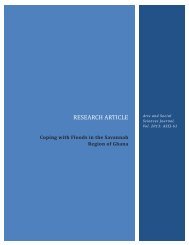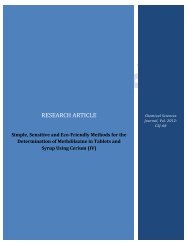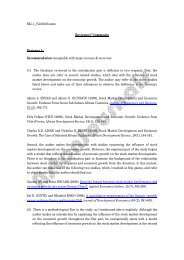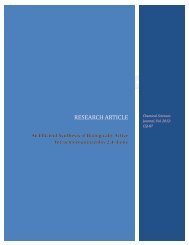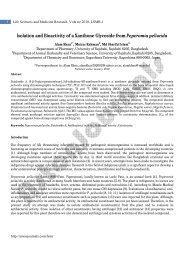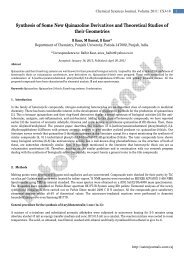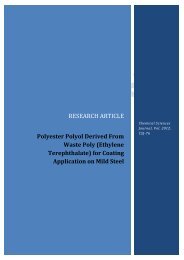Assessment of Validity, Reliability and Difficulty ... - AstonJournals
Assessment of Validity, Reliability and Difficulty ... - AstonJournals
Assessment of Validity, Reliability and Difficulty ... - AstonJournals
Create successful ePaper yourself
Turn your PDF publications into a flip-book with our unique Google optimized e-Paper software.
Arts <strong>and</strong> Social Sciences Journal, Volume 2011: ASSJ-161<strong>Assessment</strong> <strong>of</strong> <strong>Validity</strong>, <strong>Reliability</strong> <strong>and</strong> <strong>Difficulty</strong> Indices for Teacher-builtPhysics Exam Questions in First Year High SchoolG J<strong>and</strong>aghiDepartment <strong>of</strong> Management, University <strong>of</strong> Tehran, Qom Campus, Tehran, Iran.Correspondence: Gholamreza J<strong>and</strong>aghi, j<strong>and</strong>aghi@ut.ac.irAccepted: January 5, 2011; Published: February 27, 2011AbstractThe purpose <strong>of</strong> the research is to determine high school teachers’ skill rate in designing exam questions in physics subject. The statisticalpopulation was all <strong>of</strong> physics exam shits for two semesters in one school year from which a sample <strong>of</strong> 364 exam shits was drawn usingmultistage cluster sampling. Two experts assessed the shits <strong>and</strong> by using appropriate indices <strong>and</strong> z-test <strong>and</strong> chi-squared test the analysis <strong>of</strong> thedata was done. We found that the designed exams have suitable coefficients <strong>of</strong> validity <strong>and</strong> reliability. The level <strong>of</strong> difficulty <strong>of</strong> exams was high.No significant relationship was found between male <strong>and</strong> female teachers in terms <strong>of</strong> the coefficient <strong>of</strong> validity <strong>and</strong> reliability but a significantdifference between the difficulty level in male <strong>and</strong> female teachers was found (P
2 Research ArticleIn this study, the content validity <strong>of</strong> the exam questions was assessed in two ways. In the first method we used a twodimensional table. One dimension was educational goals <strong>and</strong> the second dimension was the content <strong>of</strong> the course materials [4].The second method applied for assessing content validity was a questionnaire with Likert scale in which two physics educationexpert evaluated the extent <strong>of</strong> compatibility <strong>of</strong> exam questions with course contents. For assessment <strong>of</strong> face validity <strong>of</strong> teacherbuiltexams, we used a 12-item questionnaire answered by two physics experts.3. <strong>Reliability</strong>To assess the reliability <strong>of</strong> the tests, we needed to use a number <strong>of</strong> experts to mark the exam papers in order that the markingdoes not affect the marker’s opinion [4]. In this study, we asked two teachers to mark the exam papers separately <strong>and</strong> usedKendal agreement coefficient to check the agreement <strong>of</strong> the two markings.4. <strong>Difficulty</strong> Coefficient <strong>and</strong> Discriminant CoefficientBecause all <strong>of</strong> physics exam questions were open questions, we used the following formula for calculating the difficultycoefficient (DifCo).DifCoefWherequestion ( i)MN MS ( i) W ( i)B* mM S (i) = sum <strong>of</strong> marks for Strong group in question iM W (i) = sum <strong>of</strong> marks for Weak group in question iN B = number <strong>of</strong> students in both groupsMi = total mark <strong>of</strong> question iiIn addition, the Discriminant Coefficient (DisCo) was calculated based on the following formula [6].DisCoefquestion( i)MnS ( i) W ( i)g M* miwhereM S (i) = sum <strong>of</strong> marks for Strong group in question iM W(i) = sum <strong>of</strong> marks for Weak group in question in g = number <strong>of</strong> students in one groupm i = total mark <strong>of</strong> question i5. ResultsThe percentages <strong>of</strong> papers were almost equal in terms <strong>of</strong> students’ sex (49% males <strong>and</strong> 51% females). The characteristics <strong>of</strong> theexam questions are summarized in Table 1.E-ISSN: 21516200
Arts <strong>and</strong> Social Sciences Journal, Volume 2011: ASSJ-163Table 1. Exam characteristics by book chapters.Characteristic Knowledge Concept Application Totalchapter Mark Percent Mark Percent Mark Percent1 42.5 10.1 26.5 6.3 19.5 4.7 88.52 32.5 7.8 43.75 10.4 10.5 2.5 86.753 39.75 9.4 60.5 14.4 0 0 100.254 26 6.2 44.5 10.6 0 0 70.55 24.5 5.8 45.25 10.8 4.25 1 74Total 165.25 39.3 220.5 52.5 34.25 8.2 420Table 1 shows that almost half <strong>of</strong> the physics questions were on concept (52.5%) <strong>and</strong> smaller percentages on knowledge (39.3%)<strong>and</strong> application (8.2%). There were no questions on analysis, combination <strong>and</strong> evaluation in the exams.As stated before, the agreement <strong>of</strong> teacher’s evaluations was calculated using Kendal’s agreement coefficient. The value <strong>of</strong> thecoefficient was 0.54 which was significant at p-value <strong>of</strong> 0.002. The Kendal’s agreement coefficient for face validity <strong>of</strong> thequestions based on the evaluation <strong>of</strong> expert teachers was 0.49 <strong>and</strong> significant at p-value
4 Research ArticleTable 3. Chi-square test for comparison <strong>of</strong> discriminant coefficients between female <strong>and</strong> male teachers.Discriminantlevel# <strong>of</strong> questions from femaleteachers# <strong>of</strong> questions from maleteachersChi-squaredvalueDegrees <strong>of</strong>freedomp-value0-0.2 32 280.21-0.4 74 460.41-0.6 50 370.61-0.8 31 310.81-1 27 242.902 4 0.574Table 3 shows no relationship between the teacher’s sex <strong>and</strong> the discriminant level <strong>of</strong> the questions.6. DiscussionOne <strong>of</strong> the important issues in any teaching <strong>and</strong> learning system is the quality <strong>of</strong> the students. There should be some st<strong>and</strong>ardsfor exam questions so that we have the same <strong>and</strong> high level <strong>of</strong> quality among all educational organizations’ output. Although theachievement <strong>of</strong> students in their course <strong>of</strong> study is important, the performance <strong>of</strong> teachers is also <strong>of</strong> great importance. One <strong>of</strong>the factors in the performance <strong>of</strong> teachers is good examination <strong>and</strong> good marking. Exam questions play a vital role in students’achievement. The level <strong>of</strong> difficulty, discrimination, validity <strong>and</strong> reliability <strong>of</strong> exam questions must be ensured in order to havegood outputs. In this study, we concluded that some <strong>of</strong> these factors could differ among different teachers in terms teacher’ssex. Female teachers tend to design more difficult questions than males. This may be because <strong>of</strong> the performance <strong>of</strong> the femalestudents [7]. We also found that a high percentage <strong>of</strong> exam questions concentrate on concept (52.4%) <strong>and</strong> knowledge (39.3%)whereas the small percentage applications. This may be because <strong>of</strong> the nature <strong>of</strong> quantitative sciences like physics. Thesepercentages may <strong>of</strong> course change when the topic <strong>of</strong> the course changes. In summary, teachers need to be assessed <strong>and</strong>evaluated during their teaching process to ensure the quality <strong>of</strong> their performance.AcknowledgementThis research was funded by Education <strong>and</strong> Teaching Organization <strong>of</strong> Qom Province <strong>of</strong> Iran.References[1] Crooks TJ, 1988. The impact <strong>of</strong> classroom evaluation practices on students. Review <strong>of</strong> Educational Research, 58(4): 438-481.[2] McKeachie WJ, 1986. Teaching Tips (8th edn). Lexington, Mass.: Heath.[3] Wergin JF, 1988. Basic Issues <strong>and</strong> Principles in Classroom <strong>Assessment</strong>. In JH McMillan (ed.), Assessing Students' Learning.New Directions for Teaching <strong>and</strong> Learning, no. 34. San Francisco: Jossey-Bass.[4] Seif AA, 2004. <strong>Assessment</strong> <strong>and</strong> Evaluation in Education. Doran Publication, Tehran, Iran.[5] Lotfabadi H, 1997. <strong>Assessment</strong> <strong>and</strong> Evaluation in Psychological Sciences. Samt Publication, Tehran, Iran.[6] Kiamanesh AR, 2002. <strong>Assessment</strong> <strong>and</strong> Evaluation in Physics. Ministry <strong>of</strong> Education Publications, Tehran, Iran.[7] J<strong>and</strong>aghi G, 2008. The relationship between undergraduate education system <strong>and</strong> postgraduate achievement in statistics.International Journal <strong>of</strong> Human Sciences, 5(1): education section.E-ISSN: 21516200



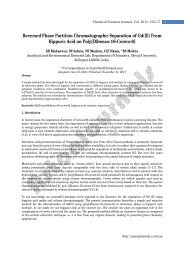
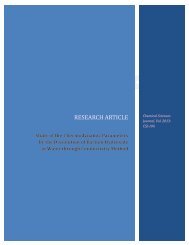
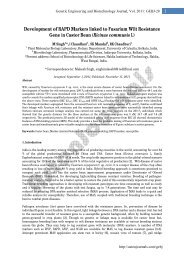
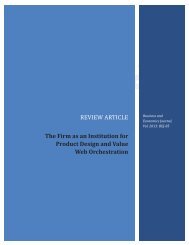
![[1,4]-benzodiazepine-2-one Derivatives as Potent - AstonJournals](https://img.yumpu.com/49117784/1/184x260/14-benzodiazepine-2-one-derivatives-as-potent-astonjournals.jpg?quality=85)
